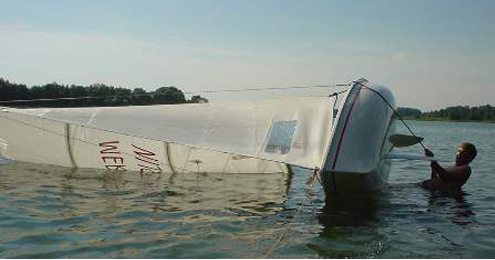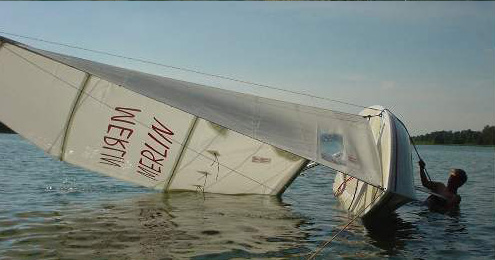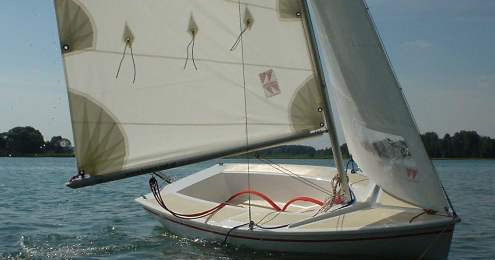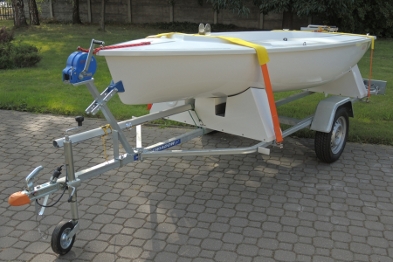FAQ - frequently asked questions and our answers to them.
An open-deck boat or a cabin boat?
Sometimes we hear that for the price of a new MERLIN, a customer can buy a used cabin.
If we have a plot with a house on a lake, why do we need a cabin? Bigger boat – bigger trouble. Old boat – big trouble. The pleasure of sailing on open-deck yachts is also much greater than on cabins. It is mainly on them that you can feel the real taste of sailing.
If someone does not have a plot with a house by the water, it is probably best to charter a yacht with a cabin and spend the holidays on it. Buying an old cabin in such a case means costs and troubles with keeping the boat on the water, as well as troublesome repairs and renovations. It only makes sense if we have a lot of time and spend the whole summer sailing.
What for children - DELTA or OPTYMIST?
The parent has no chance to get on board and swim with the child. Sailing has to be taught by a coach from a motorboat, which is not always pleasant and sometimes discouraging.
DELTA is not much bigger than OPTYMIST, but it has been designed completely differently. Its load capacity is 200 kg and this is not just a theoretical value – you can swim well with such a load. The cockpit is much more spacious and can comfortably fit two adults. Having such a sailboat, you can sail with your children and teach them how to sail by yourself, having a nice time.
Additionally – DELTA sails much faster than OPTYMIST, it is easier to rig and use.
How is it with the unsinkability of yachts KAMA?
The vast majority of yachts have closed buoyancy chambers filled with air. Usually this is enough, but not always. In the case of major damage or small, but in sensitive places, air can be displaced by water and the boat will simply sink.
In our yachts it is different – all hulls are glued with foam material ensuring unsinkability. Boat users KAMA they can have complete confidence in them, even in the most difficult moments.
MERLIN has foam placed on the bottom under the cockpit floor, DELTA in the sides of the cockpit, PROTON – in the front and rear chambers occupying almost the entire cross-section of the fuselage, and FIREFLY in a few chambers located under the floor of the cockpit.
Which version of MERLIN to choose?
The choice is not easy and requires thought. To put it simply, we usually recommend the following:
sea and large lakes – Standard or Basic
solo swimming – Basic or Standard
novice sailors – Standard or Basic
seasoned sailors – Standard or Sport
children – Standard
larger youth – Sport or Standard
elderly – Basic or Standard
fond of strong winds – Standard
It is usually the case that someone who buys Merlin, after gaining experience and confidence in the boat, starts sailing much better and more confidently, does not avoid strong winds and starts “going crazy”. It is worth taking this into account when choosing your boat.
Our favorite version? Standard and sailing in two people or alone.
Approximate sales structure in Poland: Basic – 10%, Standard – 60%, Sport – 30%.
Where MERLIN has the sword?
The sword in MERLIN is not visible, neither is the box and we hear this question very often.
Most of the centerboard box is hidden under a slightly raised section of the bottom of the cockpit. It also protrudes a bit forward and you can see it in the forepeak, and back – up to the water drain (water from the cockpit flows into the box). Structurally, the box supports the cockpit floor, and the floor stiffens the box.
The centerboard is rotatable, made of composite, profiled, completely hidden in the bottom of the boat, and it is controlled by two lines – the halyard and the double halyard led out through the guides in the cockpit floor. The halyard is used to lift (i.e. pull into the hull) the daggerboard and is fixed in the jaw cleat. The position of the sword is indicated by a plastic ball attached to the waves. The sword is fully down when the ball rests against the grommet. To lower the daggerboard, a double-half fastened in a grooved cleat with a safety device is used.
The solution with two lines is very practical in case of getting seaweed into the box or the sword jamming after a long stay on the water (snails, algae, etc.). A few alternating movements with both lines are enough then and the sword works properly. Two lines also allow you to precisely and unambiguously determine the position of the sword.
While swimming (except for reaching the shore) the halyard and the double halyard should be fastened on the cleats, and the centerboard fixed – in any position, not necessarily in the extreme ones. When hitting an underwater obstacle, the force in the counter-wave will trigger the fuse, releasing the line and the ability to automatically raise the sword.
When taking the sailboat out of the water, remember to pull the daggerboard into the hull and tie the halyard.
Can Merlin be transported on the roof of a car?
You can do this, but we do not recommend this solution. The hull of the sailboat is too long in relation to the luggage racks and it may wobble while driving. Another problem is the rigid mounting of a relatively long mast.
If you absolutely want to transport MERLIN on the roof, the boat must be upside down and bow forward.
Station wagons with long railings protruding from the roof work well. You can then attach the boat directly to the roof rails by placing crossbars of boards beforehand – thanks to this, you will get a long base to support the hull. Remember to securely fasten all crossbars so that no one slips out and falls from the car.
The straps used to fasten the boat should be at least 35 mm wide, have appropriate strength confirmed by a certified insert and have a tensioner.
Do not use thin, poor quality, cheap belts – these elements are crucial for safe transport of the boat.
MERLIN dump truck - what to do?
Merlin’s mast and boom are “corked” with polyurethane foam, and the halyards are routed outside the mast. This causes that the yacht after capsizing is very reluctant to “mushroom” – which does not mean that it will not happen, for example, as a result of the crew entering the overturned hull or the action of waves and wind. The cockpit protrudes entirely above the water surface and remains dry after placing the boat. Immediately after capsizing, check if the crew is complete and has life jackets on, and then start putting the boat down. One person can easily do this by doing the following:
- throw the topsheet of the foresail over the hull near the centerboard
- chain one end of the mooring line to the front cleat, tie the other end to yourself with a rescue knot – Merlin can sail away without us quite quickly
- pull the jib’s sheet with your feet resting on the bottom or a submerged collar by the side – you should assume an upright position (the other person can help by pulling up on the sword)
- the boat will start to rise slowly – it will take a few seconds
- get on the Merlin – preferably on the foredeck just before the shroud – the bow can be immersed deeper, it is easy to grab the mast and you will not get hit on the head by the boom.
In the event that the boat capsizes, pull the jib and press against the side to the widest point of the yacht to turn on its side and proceed as described above.
The operation of putting the yacht back after capsizing is best practiced beforehand in convenient conditions – then it will become really easy.




What trailer to transport MERLIN or DELTA?
It is best to transport the boats on the car trailer we offer. It has two handguards made of composites that perfectly support the hull. The stocks are universal and fit both MERLIN and DELTA – you only need to change their spacing. Our trailers have sealed bearings and a detachable beam behind the lights – you can drive them into the water. They are also equipped with a maneuvering wheel and a winch. Thanks to the winch, you can leave the car on a hard surface without fear of “drowning” or burying it, attach the winch strap to the towing hook and lower the trailer into the water. This makes it possible to launch boats in various places, not only on slips. You can always take the boat off the trailer and carry it over the water.

Other boat trailers are also suitable for transporting the MERLIN or DELTA. You just need to remember about good support of the hull – point supports usually do not give such a possibility. Too few or improper adjustments can cause serious damage to the bottom of the boat.
Some customers transport our sailboats on luggage trailers. Usually, they buy a stand for storing the yacht and place it on the bottom of the trailer, for example, on polystyrene boards. The point is to raise the hull higher so that it does not catch on the sides of the trailer. This is a good way to properly support the bottom of the boat and to use popular and cheap luggage trailers. It is only necessary to check whether the drawbar is long enough so that the sailboat does not catch on the rear of the car or does not outweigh the trailer to the rear.
Can DELTA be transported on the roof of the car?
A lot of customers do just that, especially when it’s occasional. The boat should then be transported with the bow forward and in an inverted position – bottom up.
It’s best if the car has rails protruding from the roof. After laying on them across two boards with a length of about 150 – 160 cm, we get a perfect place to lay the DELTA. It is enough to tie the whole thing firmly with transport straps in such a way as to immobilize the boards against the railings.
If the car does not have protruding rails, a roof rack or at least crossbars mounted between the rails will be necessary. Sometimes the trunk is so small that it can enter the cockpit of an inverted DELTA and proper support will not be possible. Then use two additional boards and place the boat on them.
The fastening straps should be at least 35 mm wide, have adequate strength confirmed by a certified insert and have a tensioner. Do not use thin, poor quality, cheap belts – these elements are crucial for safe transport of the boat. It is also necessary to fix any boards so that one of them does not slip out and fall from the car.
To prevent the hatches of the boat’s trunks from hitting the roof, you can cover them with tape (yellow painter’s tape is good).
If the car is cramped, DELTA can carry a sword, spars and oars on the roof of the car. The sword should be placed in the position of the bench, the spars should be placed on it (a cover for them is very useful then) and possibly oars, and then the whole thing should be fixed with ropes using the eyelets at the sword chest.
DELTA tipper - what to do?
Both parts of the mast and the boom of the DELTA are closed with plugs and the halyard is routed to outside the mast. This makes it difficult and delays the capsizing of the yacht, but it should be done remember that this can happen. It is important to proceed as soon as possible after a capsize placing the yacht. When the DELTA is lying on its side, the cockpit almost completely protrudes above the surface water and little water remains in it after the boat is put down. Immediately after capsizing, check if the crew is complete and wearing life jackets, then start putting the boat down. One person can easily do this by following the following way:
- extend the centerboard completely from the hull
- pull yourself up on the sword
- a second person can help by trying to turn the transom
- the boat will start to rise slowly – it will take a few seconds
- boarding – preferably near the mast or transom
In the event that the boat capsizes, push the side of the w the widest point of the yacht to turn on its side and proceed as described above.
DELTA can sail away without us quite quickly, so it’s good to do it earlier attach one end of the mooring line to it and tie the other end to yourself with a rescue knot.
It is best to practice the operation of putting the yacht down after capsizing in a convenient place beforehand conditions – then it will become really simple.
How to transport the PROTON?
For the PROTON we offer a special stand – a trolley for storing it and moving it over short distances. After lowering the wheels, you can ride it around the club, parking lot, etc. Virtually all boat buyers order it.
For further transport of the PROTON, it is easiest to use a luggage trailer or a platform with a flat floor. After placing the boat on the stand on them, all you need to do is fasten the whole thing with straps. It is best to use two straps to secure the stand to the trailer and two additional straps to secure the boat to the stand. The belts should be 50 mm wide, have a certificate and a tensioner. Don’t forget to block the forward movement – for example by inserting boards between the front board and the stand. This can be very useful when braking sharply.
How to maintain and winter yachts?
Composite boats generally do not require any special maintenance, but it is certainly good to wash them thoroughly and sometimes cover them with special preparations for laminates or wax for car bodies.
The MERLIN or DELTA is best stored on the stand we offer, which provides good support for the hull. These boats can also stand on our slip trolleys or car trailers. Old tires should definitely be avoided – they can deform the cover and also damage it chemically. The PROTON is stored using a special stand we offer – a trolley with lowered wheels – thanks to which it can also be easily moved over short distances.
The ideal place for wintering yachts is a room – then it is enough to loosely throw a sheet of painter’s foil on the deck so that it does not get dusty. A little worse when the boat has to be “under the cloud”. It should then be covered with a thick tarpaulin or foil and well protected against being blown away by the wind. It is important that the cover does not lie directly on the deck, but, for example, on boards arranged in such a way as to ensure ventilation and water flow.
During the wintering of the yacht, you should pay attention to cats, martens and other animals that may want to live in the boat.
Sails and ropes should be thoroughly dried and stored loosely rolled up in a warm and dry place.
Mast and boom are best wrapped in foil. Freely support the mast on two supports spaced apart by about 1/2 of its length. It can also be suspended in a similar way, e.g. from the ceiling.
What to do so that it does not grow on the bottom of the boat?
Usually, small sailing boats do not stay in the water all the time and are periodically pulled ashore. The vast majority of them have no bottom protection.
However, if we plan to keep the yacht for a long time in a water area where intensive fouling occurs, it may be advisable to paint the bottom with antifouling paint – the so-called antifouling. In different reservoirs, the rate of fouling varies greatly, so it is best to get information from local water sportsmen in advance. Antifouling usually lasts for a couple of seasons, then needs to be reapplied periodically.
We offer antifouling as an option only for FIREFLY, with other boats, it is best to order it to be made by a local boatbuilder.



